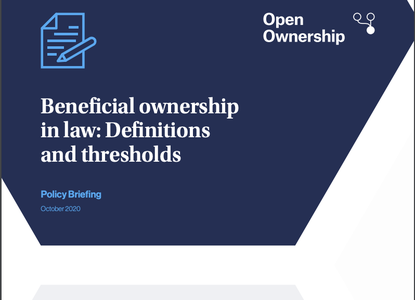Updated January 2023
Beneficial ownership should be clearly and robustly defined in law, with sufficiently low thresholds set to ensure all relevant ownership and control interests are disclosed
- A robust and clear definition of beneficial ownership should state that a beneficial owner should be a natural person, and should cover all relevant forms of ownership (including deriving benefit from) and control, specifying that ownership and control can be held both directly and indirectly.
- There should be a single, unified definition in law in primary legislation, with additional secondary legislation referring to this definition, specifying what the definition means when applied to certain corporate vehicles, such as legal arrangements or state-owned enterprises (SOEs).
- Legislation should include a broad, catch-all definition of what constitutes beneficial ownership, coupled with a non-exhaustive list of example ways in which beneficial ownership can be held.
- Thresholds should be set sufficiently low so that all relevant individuals with beneficial ownership and control interests are included in declarations. A risk-based approach should be considered to set lower thresholds for particular sectors, industries, or people, depending on the policy objectives set.
- Definitions should include a clear prohibition of who does not qualify as a beneficial owner, including agents, custodians, intermediaries, and nominees acting on behalf of another person qualifying as a beneficial owner.
- When the criteria to be a beneficial owner are met through two or more individuals acting jointly, each individual should be considered a beneficial owner, and each individual should be assumed to have combined ownership and control in full. Definitions should specify when joint action is assumed.
- Where no individual meets the definition of a beneficial owner, countries should require the disclosure of the name of a natural person in a senior role with managerial responsibility for the corporate vehicle in question, making clear that this person is not a beneficial owner.
Clearly defining beneficial ownership and ensuring it covers all relevant forms of ownership and control makes a disclosure regime less vulnerable to exploitation by those seeking to abuse the system. Ownership should include the right to use, enjoy, and derive income or other benefits from a corporate vehicle or its assets.
Using sufficiently low thresholds to determine ownership or control reduces the risk that someone with relevant ownership or control remains hidden. Extremely low thresholds may become too labour or cost-intensive without providing useful insight into significant ownership or control. A risk-based approach can help determine appropriate thresholds that balance these factors, bearing in mind the country’s policy aims. Lower thresholds may be warranted for high-risk sectors, industries, and people.
Definitions should be harmonised nationally for clarity and to facilitate compliance. Where possible, definitions should be harmonised regionally and internationally, or similar minimum standards should be adopted. When defining beneficial ownership, governments should give consideration to how to treat minors and other legally incapable individuals within the context of the legal system.



